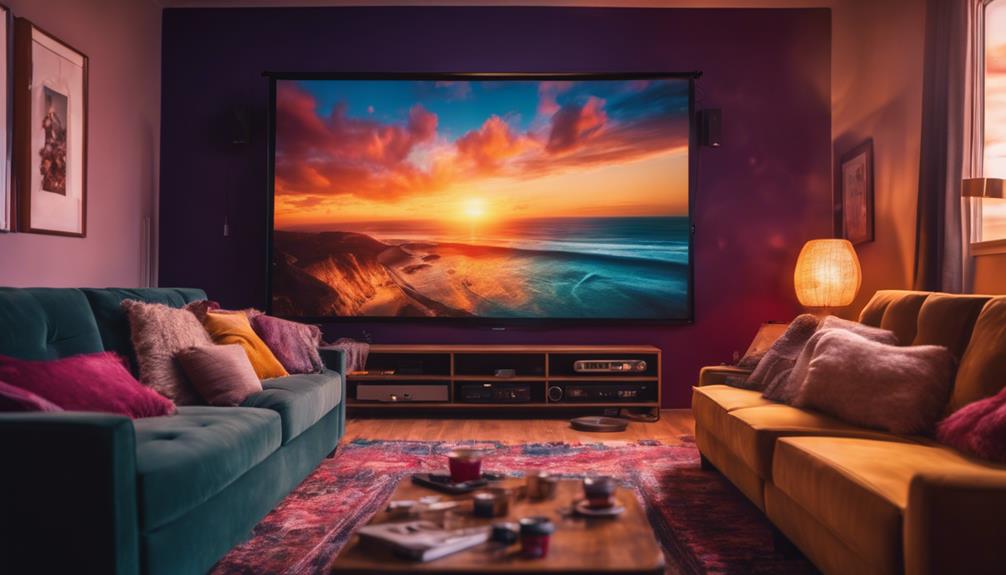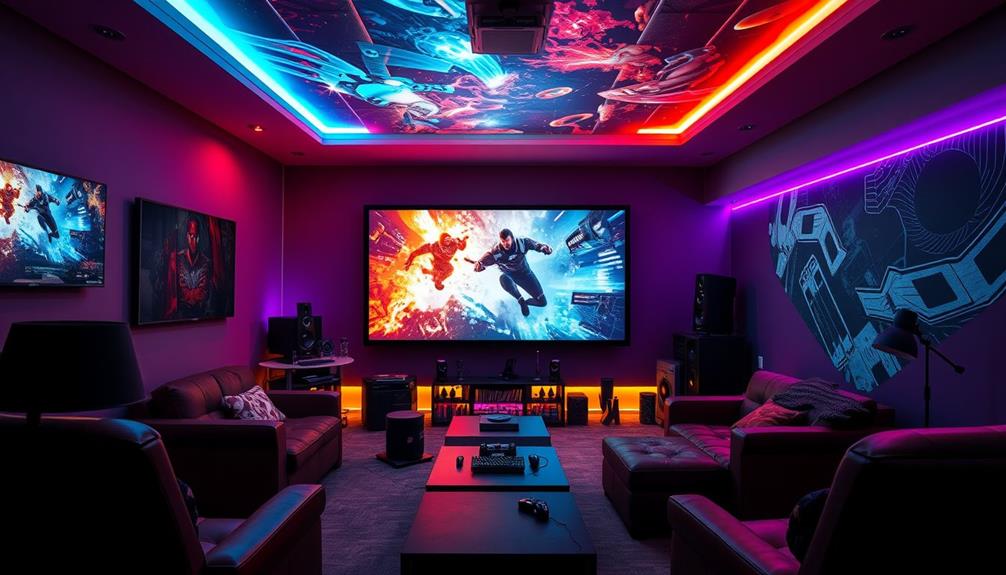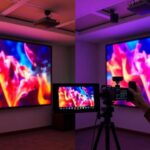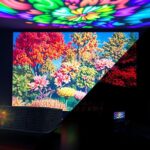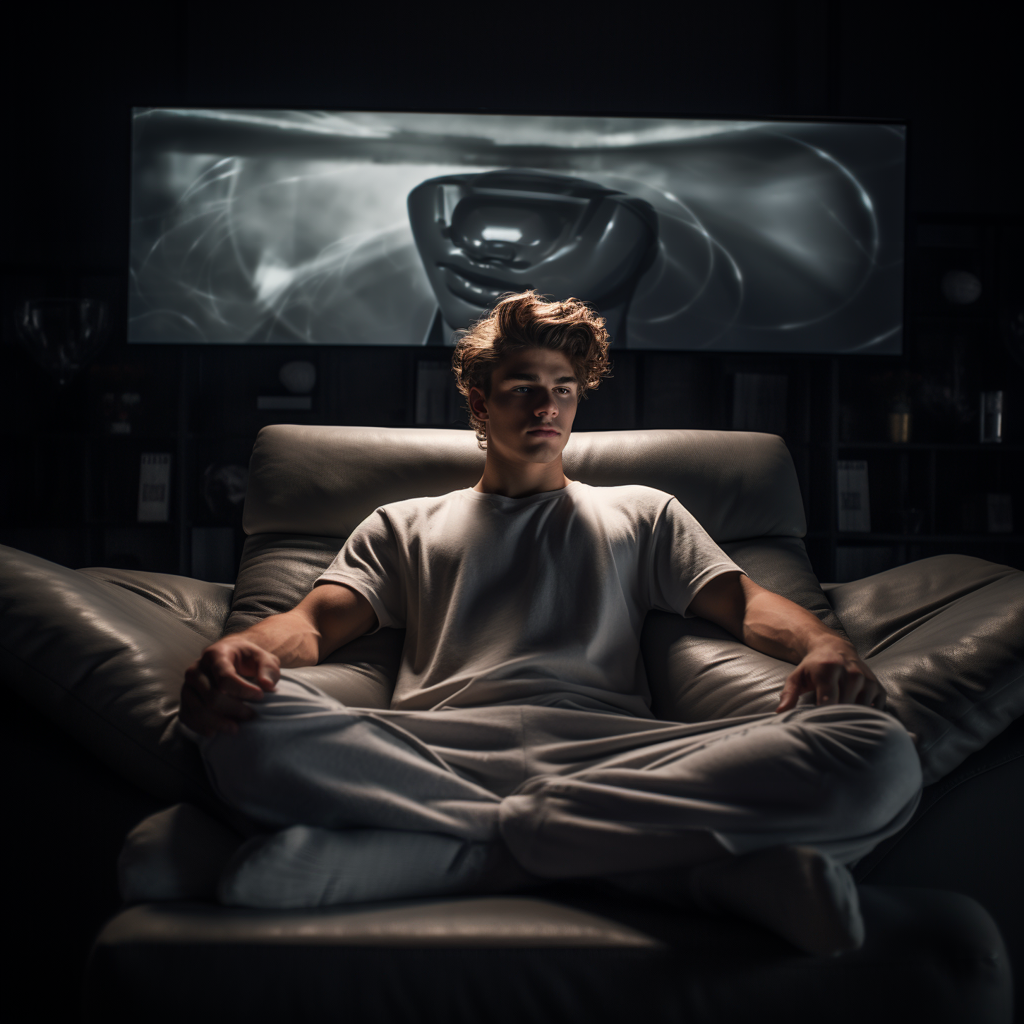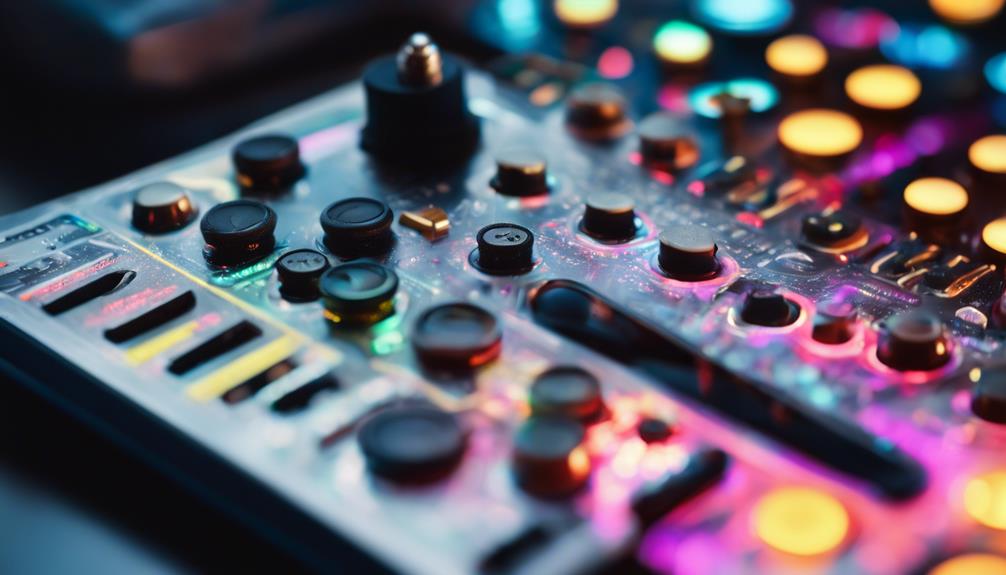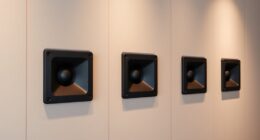Color accuracy plays an essential role in home cinema projectors, deeply affecting your viewing experience. When colors are true to life, you connect more emotionally with the film, enhancing your enjoyment. Projectors that meet at least 90% of the DCI-P3 color space standard for quality reproduction make a noticeable difference. Proper calibration is key to achieving this accuracy, aligning visuals with the filmmaker's intent. Additionally, precise colors help convey mood and atmosphere, especially in dramatic or horror genres. You'll discover even more about how color impacts your cinema experience and the best projectors to evaluate next.
Key Takeaways
- Color accuracy enhances emotional connection to films, leading to greater viewer satisfaction and overall enjoyment.
- Adhering to Rec. 709 standards and achieving low dE2000 values ensure consistent and realistic color reproduction in home cinema.
- Accurate colors are crucial for conveying mood in genres like horror and drama, enhancing the narrative and emotional depth.
- Projectors should cover at least 90% of the DCI-P3 color space to reveal richer colors and improve viewing experience.
Importance of Color Accuracy
Color accuracy isn't just a technical detail; it profoundly impacts your emotional connection to the films you watch. When you experience inaccurate colors, it can distract you from the narrative and characters, diminishing your overall enjoyment.
That's why understanding the importance of color accuracy in home cinema setups is essential. The Rec. 709 standard serves as a benchmark, ensuring that your projector reproduces colors consistently and accurately.
For ideal color accuracy, aim for a dE2000 value below 3, which indicates minimal perceptible differences to your eyes. This level of precision enhances your emotional engagement, allowing you to fully immerse yourself in the visual artistry that directors intend.
Professional calibration can greatly improve color fidelity, ensuring that the colors on your screen match the filmmaker's vision. With the right adjustments, you'll notice how vibrant hues and subtle shades bring depth to your viewing experience.
Investing in color accuracy not only elevates your home cinema experience but also strengthens your connection to the stories being told, making every film an enchanting journey worth experiencing.
Emotional Impact of Color

Accurate colors in your home cinema can profoundly affect how you feel while watching a film, as they evoke specific emotions and enhance the overall atmosphere of the story. When you experience color accuracy, it greatly boosts your emotional engagement. Specific colors can trigger distinct emotional responses, influencing your mood during film viewing.
Studies reveal that viewers prefer films with excellent color reproduction, underscoring that color fidelity is essential for maintaining viewer interest and satisfaction. This is especially true in genres like horror and drama, where accurate color representation conveys the intended mood and emotional depth, enhancing the narrative impact.
On the flip side, color inaccuracies, like unwanted tints, can distract you and detract from the film's narrative, leading to a diminished emotional connection. This is particularly important in children's films, where early exposure to accurate colors aids in cognitive development, helping kids associate colors with feelings and experiences.
Factors Influencing Color Fidelity
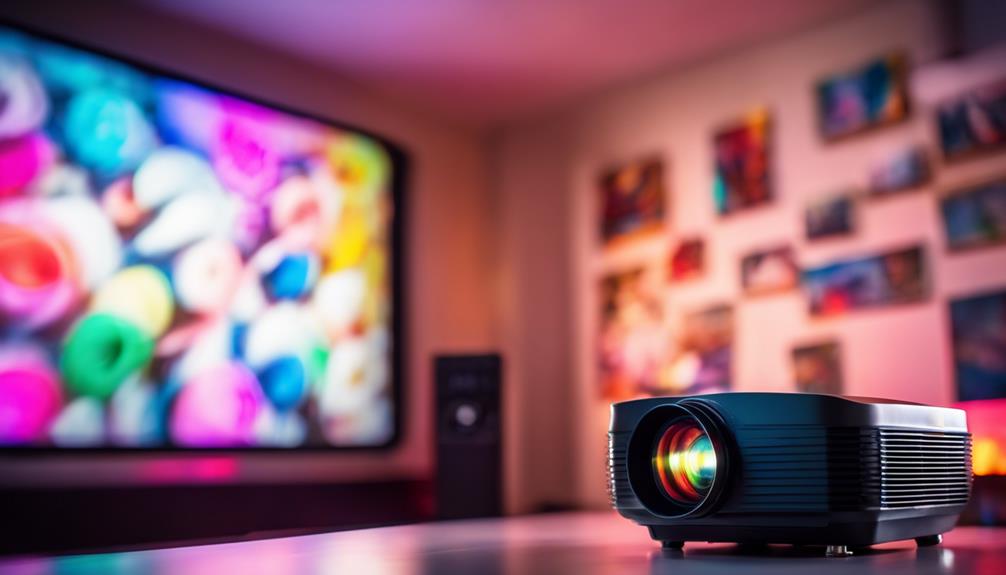
Several factors influence the color fidelity of home cinema projectors, including the projector's color gamut range and ambient lighting conditions.
For ideal color accuracy, look for projectors that cover at least 90% of the DCI-P3 color space. This guarantees a rich and vibrant color experience in your viewing environment.
The dE2000 value is another essential factor; a projector should have a dE2000 value below 3 to be considered color accurate. Values under 1 are virtually indistinguishable to the human eye, making them perfect for immersive viewing.
Ambient lighting plays a significant role as well. It can drastically alter the perception of color fidelity, so it's critical for projectors to maintain color accuracy across different lighting conditions.
Calibration during production is fundamental, focusing on gamma calibration, black/white levels, and color tracking to meet industry standards.
Finally, the choice of technology matters too—DLP projectors typically deliver superior color fidelity, especially in darker environments, thanks to their advanced color processing capabilities.
Recommended Projectors for Color Accuracy
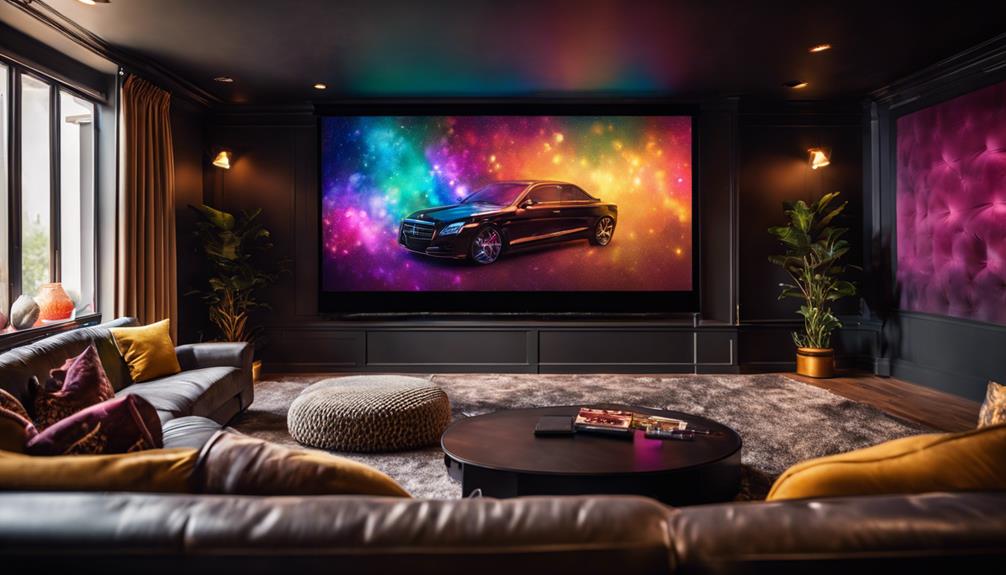
When you're looking for projectors that deliver high-quality color accuracy, several models stand out.
You'll want to take into account options like the XGIMI Horizon Pro and BenQ projectors, known for their impressive color technologies and calibration techniques.
We'll also explore how recent innovations in color technology can enhance your viewing experience.
Top Projector Picks
For those seeking vibrant and true-to-life colors in their home cinema experience, selecting the right projector is essential.
You'll want to prioritize color accuracy to guarantee your home theater delivers cinematic visuals that captivate your audience.
The XGIMI Horizon Pro is an outstanding choice, boasting true 4K resolution and covering 110% of the DCI-P3 color gamut for immersive viewing.
If you're looking for an ultra-short throw option, consider the XGIMI AURA, which utilizes ALPD technology to provide vivid colors and striking contrast.
For portability, the XGIMI Halo+ shines with its 1080p resolution and enhanced color reproduction, perfect for on-the-go cinema experiences.
However, if professional-level color accuracy is your goal, you can't go wrong with BenQ projectors.
These models are calibrated to exceed Rec. 709 standards, guaranteeing faithful color reproduction that honors filmmakers' artistic intentions.
Calibration Techniques Explained
Calibrating your projector can transform your viewing experience, ensuring colors appear vibrant and true-to-life.
Proper calibration enhances color accuracy, providing you with the best possible picture quality. Start by adjusting key settings like brightness, contrast, and color saturation. Achieving a proper grayscale balance is essential, as it helps maintain a 6500K color temperature, which is ideal for home cinema projectors.
Many projectors come equipped with a Color Management System (CMS), allowing you to fine-tune individual colors for accuracy. You might find that, out-of-the-box, some projectors already offer a good picture mode, with skin tones and primary colors looking decent. However, a professional calibration can elevate this performance, ensuring every hue is on point.
If you're considering DIY calibration, be prepared for a learning curve and an investment in specialized tools, but the results can be rewarding.
Whether you opt for professional help or tackle it yourself, the effort spent on calibration will greatly enhance your viewing experience, making every movie night a feast for the eyes.
Color Technology Innovations
Exploring the latest color technology innovations can help you choose projectors that deliver exceptional color accuracy for your home cinema setup.
For instance, the XGIMI Horizon Pro stands out with its true 4K resolution and 110% DCI-P3 color gamut, guaranteeing vivid colors that captivate your audience.
If you're looking for versatility in varying ambient light conditions, the XGIMI AURA uses ALPD technology to maintain excellent color fidelity without compromising on contrast.
For those who prefer portability, the XGIMI Halo+ incorporates the X-VUE 2.0 engine, enhancing clarity and rich color output, even in less-than-ideal lighting.
Additionally, BenQ projectors utilize their proprietary CinematicColor™ technology, going beyond Rec. 709 standards through advanced calibration instruments, assuring top-tier color accuracy.
Investing in projectors designed with optimized mechanical, electrical, and optical features guarantees an enhanced viewing experience.
With these innovations, you'll experience a true cinematic journey, where every scene bursts with lifelike colors and unmatched accuracy, making your home cinema truly extraordinary.
Color Standards and Calibration
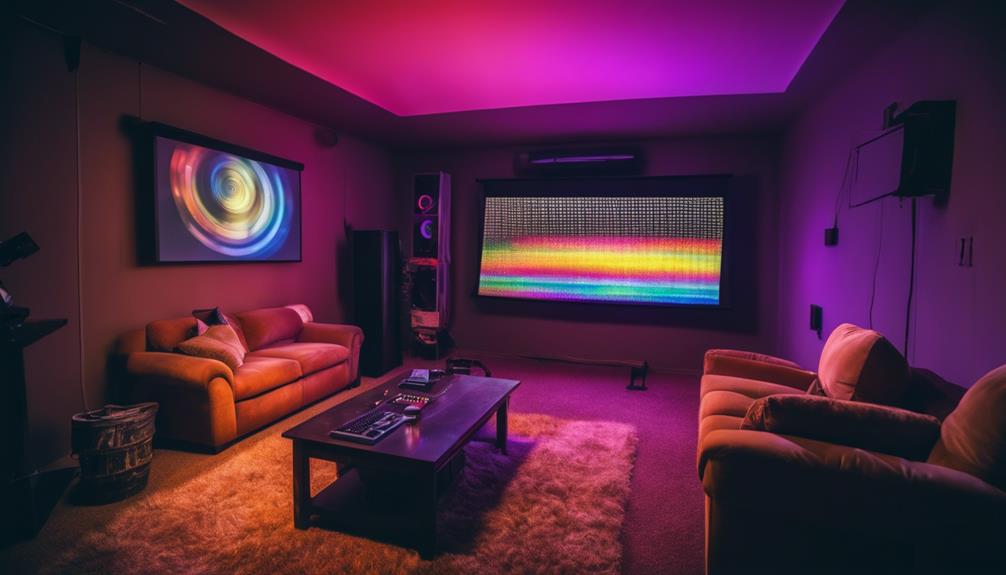
Understanding color standards and calibration is essential for achieving the best performance from your home cinema projector. The Rec. 709 color standard is critical, as it defines the color gamut, resolution, and frame rates for HD content, ensuring your projector delivers accurate color representation.
To achieve true color accuracy, the dE2000 value should be below 3, with values under 1 being nearly indistinguishable to the human eye.
Professional calibration plays an important role in this process. It involves adjusting gamma, black and white levels, and RGBCMY color tracking to meet Rec. 709 standards and enhance color fidelity. While a projector may boast a wide color gamut, it doesn't guarantee precise reproduction without proper calibration.
Fortunately, many projectors today come with user-friendly calibration options. You can fine-tune your settings for ideal color performance tailored to your viewing environment.
For those seeking the highest level of accuracy, investing in advanced calibration tools and software can make a significant difference. By ensuring your projector is calibrated correctly, you'll enjoy a more immersive and visually stunning cinematic experience.
Enhancing Viewing Experience
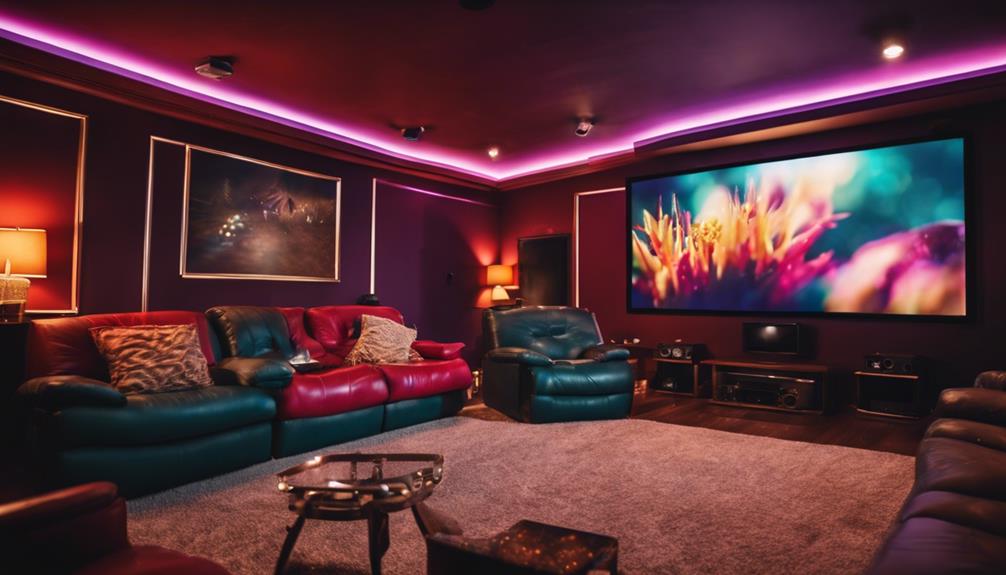
Enhancing your viewing experience hinges on accurate color representation, which immerses you in the film's emotional depth and narrative. When your home cinema projector adheres to the Rec. 709 standard, it guarantees a consistent color gamut, allowing you to enjoy a cinematic experience that aligns with the director's vision.
Projectors with a dE2000 value below 3 are considered color accurate, delivering realistic imagery that captures your attention without distraction. By choosing high-quality projectors that cover at least 90% of the DCI-P3 color space, you reveal a richer and more vibrant color palette. This not only elevates the visual quality of the content but also enhances your emotional engagement with the story being told.
Utilizing advanced calibration technologies in these projectors optimizes brightness and color execution, making sure you experience vivid and lifelike colors, even in varied lighting conditions. The result is an immersive viewing experience that captivates your senses, making every film feel like a masterpiece.
Accurate color representation is essential for transforming your home cinema into a dynamic space where every moment resonates deeply, creating lasting memories.
Examples of Color in Film
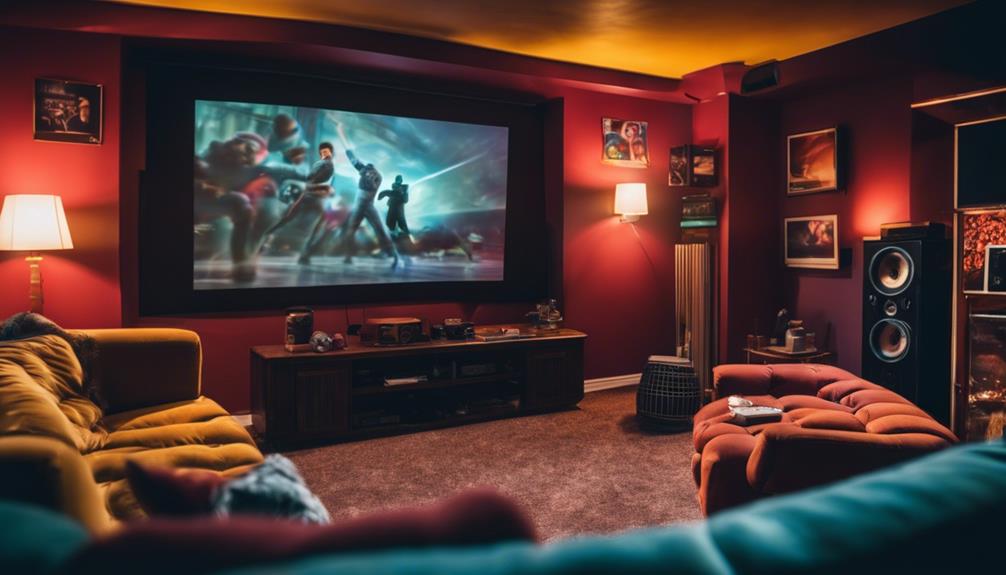
When you watch films, you'll notice how color plays an essential role in conveying themes and emotions.
For instance, the stark reds in "The Handmaid's Tale" enhance its oppressive tone, while the vibrant hues in "La La Land" illustrate character journeys.
These color choices not only shape the story but also greatly impact your perception as a viewer.
Color Symbolism in Cinema
Exploring color symbolism in cinema reveals how filmmakers use hues to evoke emotions and convey deeper meanings within their narratives.
For instance, in "The Handmaid's Tale," the prominent use of red symbolizes oppression and rebellion, establishing an emotional depth that resonates with viewers. Similarly, "La La Land" employs vibrant colors to reflect characters' dreams and aspirations, enhancing key scenes' emotional impact.
The intricate color palette in "Star Trek Discovery" creates a visually engaging experience that aligns with its themes of exploration and diversity. In "The Sixth Sense," specific colors signify different emotional states, effectively guiding audience engagement and understanding of the plot's developments.
Moreover, "Mad Max: Fury Road" showcases contrasting color schemes, using warm desert tones against cool blues to heighten tension and drama throughout the story.
By mastering color symbolism, filmmakers achieve a powerful form of cinematic storytelling that captivates viewers and deepens their connection to the narrative.
When you watch these films on a projector with excellent color accuracy, you can fully appreciate the intricate relationship between color and emotion, enriching your overall visual experience.
Impact on Audience Perception
The powerful influence of color in films greatly shapes how audiences perceive and connect with the story, impacting their emotional responses and overall engagement.
Movies like "La La Land" use vibrant colors to enhance narrative depth, drawing you into the characters' journeys and evoking specific emotional responses. Similarly, "The Handmaid's Tale" employs color to denote thematic elements, reinforcing the viewer's connection to the storyline through accurate color reproduction.
In series like "Star Trek Discovery," intricate color palettes are crucial for world-building, creating an immersive experience that captivates you as a viewer. The cinematographic techniques used to emphasize these colors considerably influence audience perception, allowing for deeper engagement with the film's themes and characters.
In horror films, accurate color reproduction—specifically through shadows and tones—plays a critical role in building tension and enhancing emotional impact. When you're watching at home, having a projector that maintains color accuracy is indispensable.
It guarantees that you experience the intended vibrancy and nuances, allowing you to fully appreciate the film's artistic vision and emotional depth. This is why choosing the right home cinema projectors matters for your viewing experience.
Engaging With Home Cinema Communities
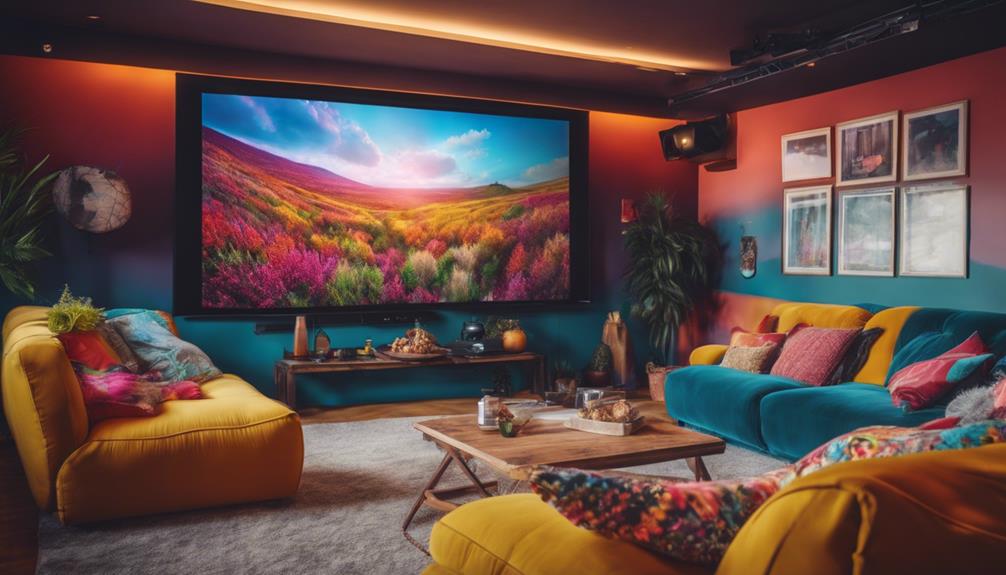
Engaging with home cinema communities enables you to share insights on projector color accuracy and gain tailored recommendations for your viewing environment. These communities are invaluable for anyone passionate about enhancing their home cinema experience. By participating, you can access expert advice on color calibration techniques that optimize your projector's performance.
Staying active in forums and social media groups keeps you updated on the latest advancements in projector technology and color standards. This knowledge allows you to make informed decisions when purchasing new equipment. Members often share their own color calibration settings, which can help you achieve a more accurate color gamut and improve your viewing experience.
Community engagement fosters a collaborative atmosphere where enthusiasts discuss the significance of color accuracy in achieving CinematicColor quality. You'll discover discussions that explore how these elements impact your enjoyment of visual media. Additionally, many communities host events and webinars that further examine these topics, enriching your understanding and appreciation of home cinema.
Frequently Asked Questions
What Is Color Gamut in Projector?
Color gamut in a projector refers to the range of colors it can display. It affects how vibrant and accurate the images look, with broader gamuts providing a more immersive viewing experience for you.
What Is Color Screen Accuracy?
While vibrant hues captivate your senses, color screen accuracy guarantees those colors reflect the creators' intent. It's about precision; high fidelity makes viewing authentic, enhancing your overall experience with striking realism and emotional depth.
How Is Screen Color Accuracy Measured?
Screen color accuracy's measured using dE2000 values, where scores below 3 show colors indistinguishable to your eye. Calibration against standards like Rec. 709 guarantees your projector accurately reproduces a wide range of colors.
What Is the Role of Color in Movies?
You might think color's just decoration, but it's essential in movies. It shapes emotions, enhances storytelling, and draws you into the narrative, making your viewing experience richer and more immersive than you might expect.
Conclusion
In the world of home cinema, color accuracy is like the heartbeat of your viewing experience; it brings life to every scene.
By investing in a projector that prioritizes color fidelity, you're not just watching a film—you're immersing yourself in its emotional depth.
So, whether you're hosting movie nights or indulging in solo viewings, embrace the power of color to elevate your enjoyment.
Remember, the right shades can transform your space into a cinematic masterpiece.
Tom is the Editor-in-Chief of 1home Theatre Projector, a website that provides news and reviews on the best home cinema experiences. With over 10 years of experience in the industry, Tom knows what makes a great home theatre projector and wants to make it easy for everyone to build the perfect setup for their needs. When he’s not busy writing or testing projectors, Tom enjoys watching classic films and spending time with his family.
